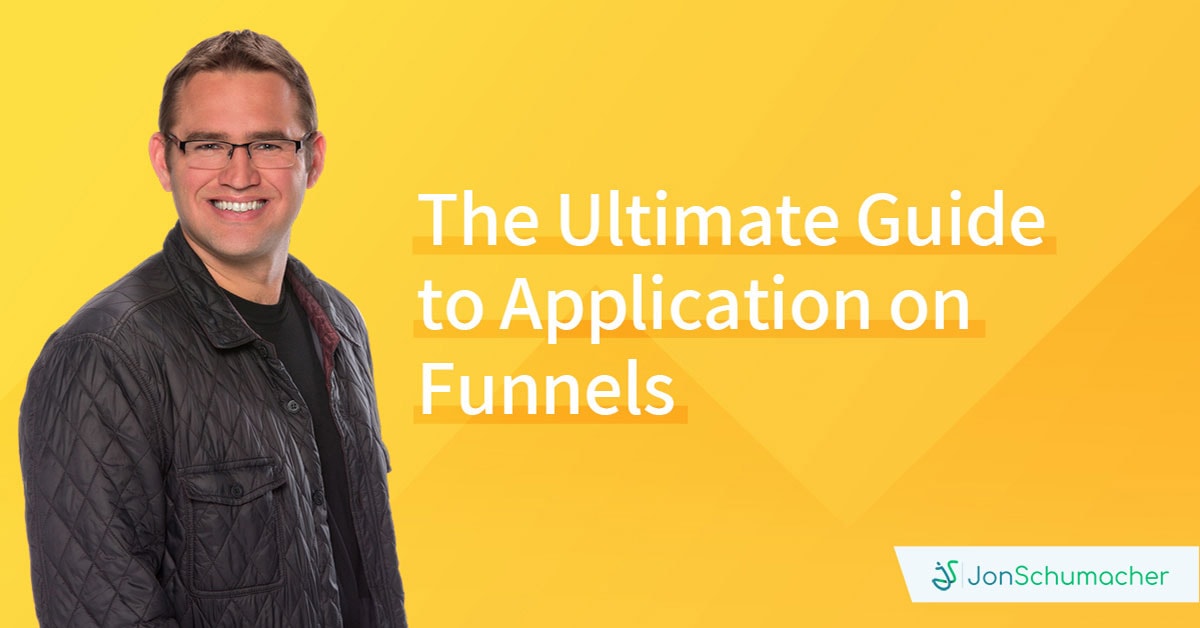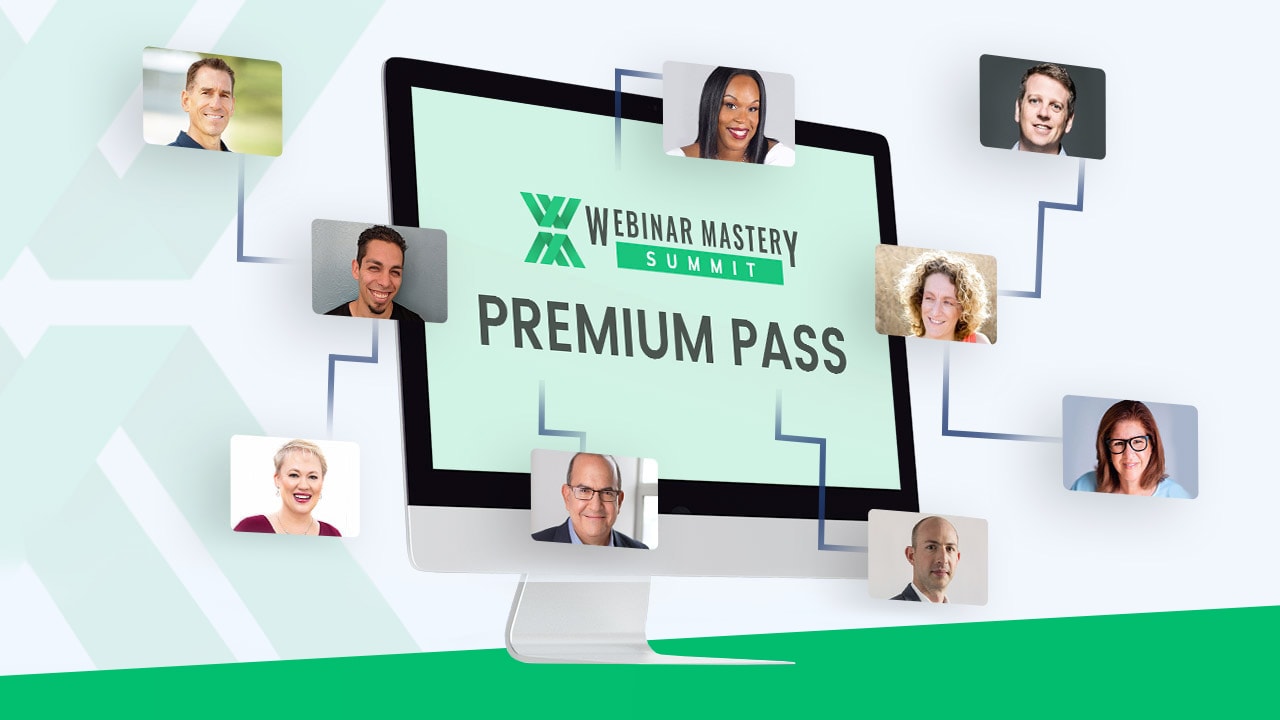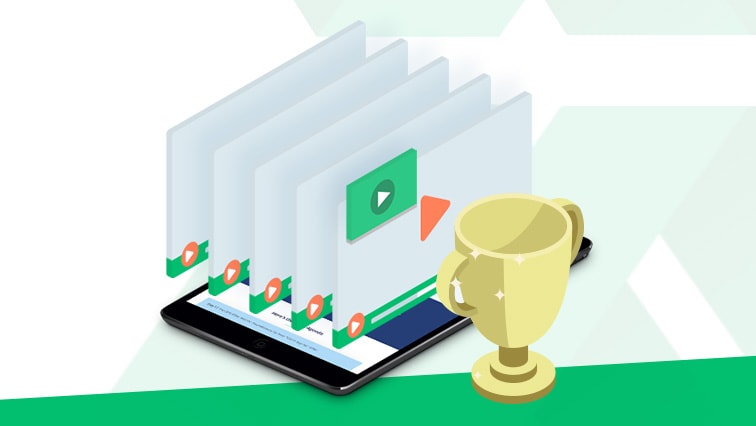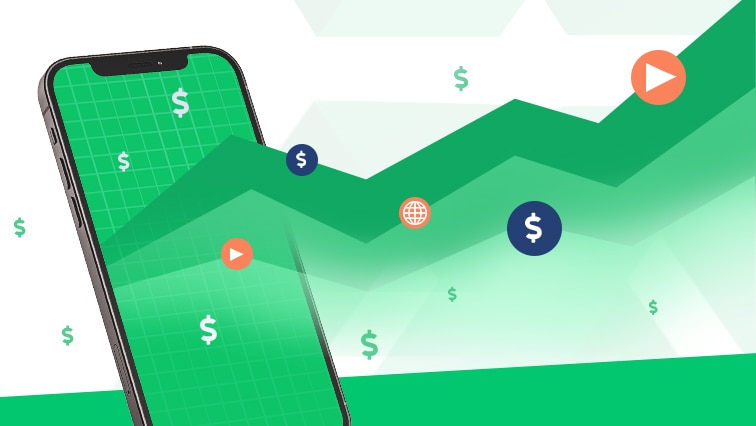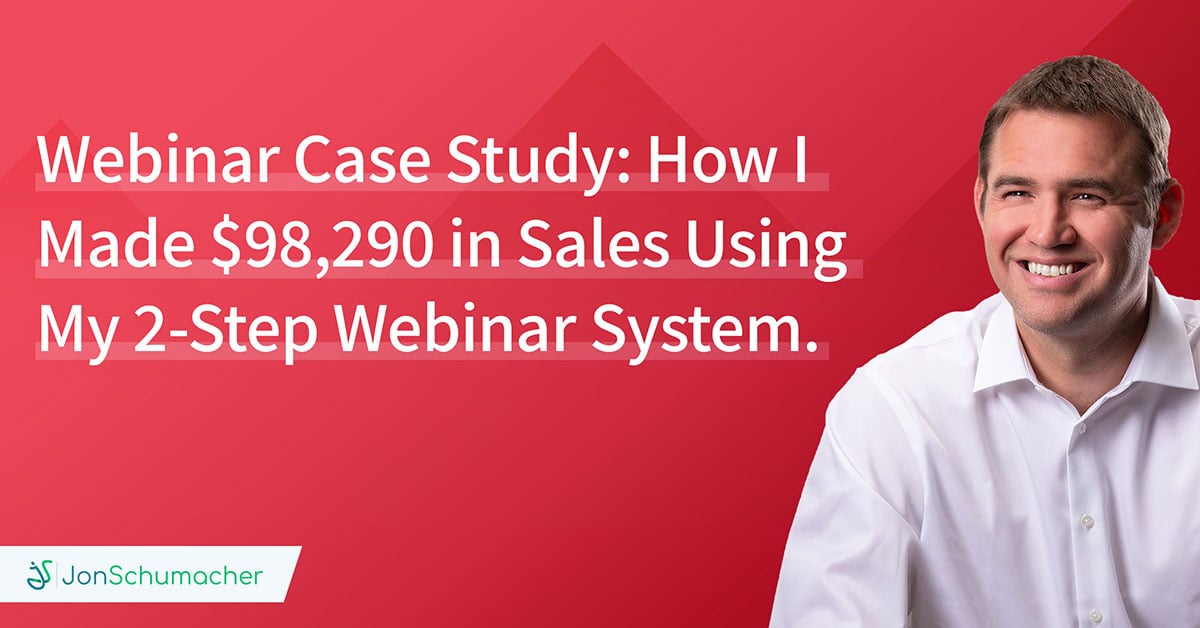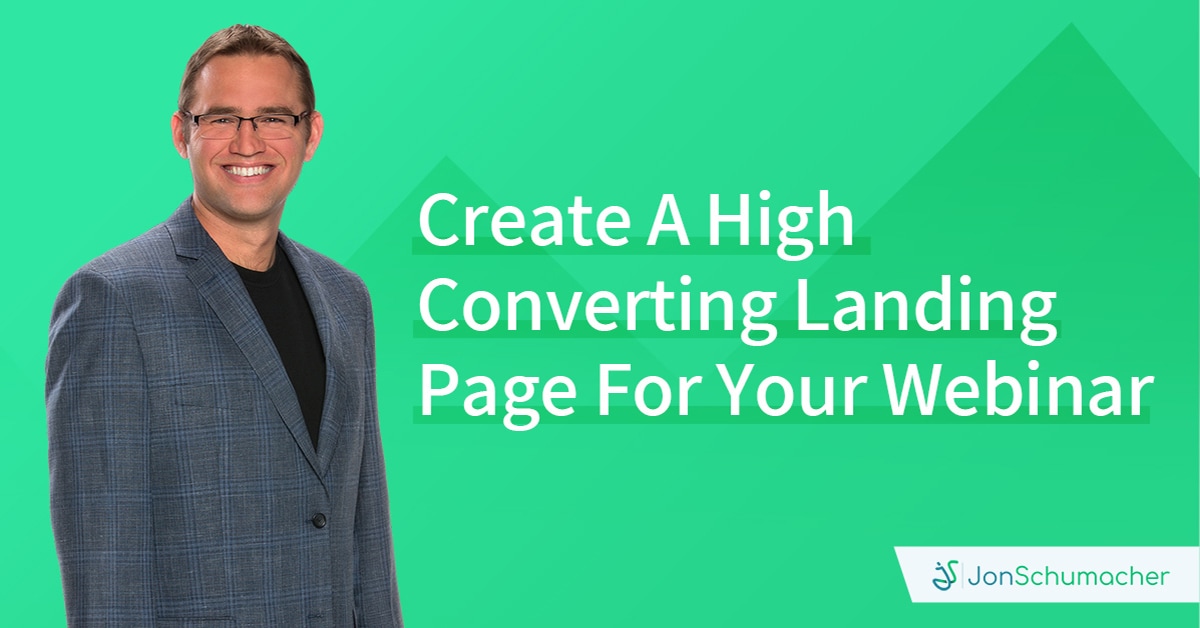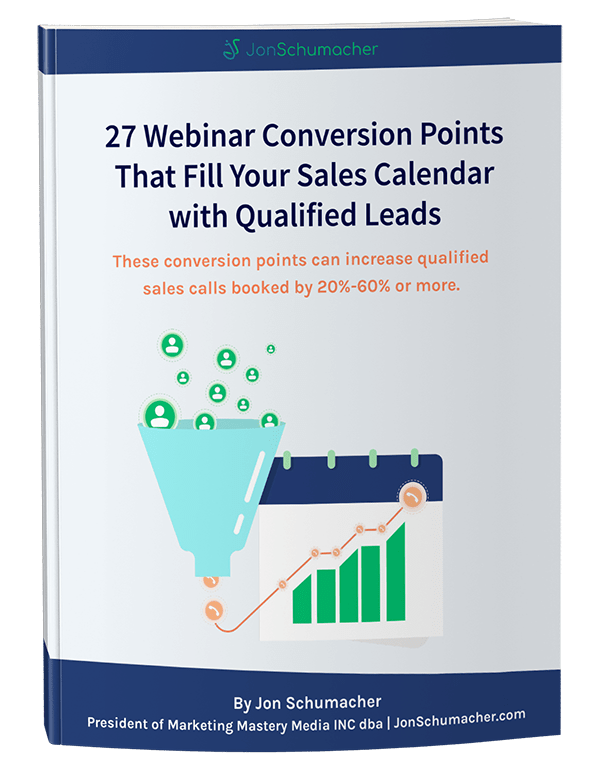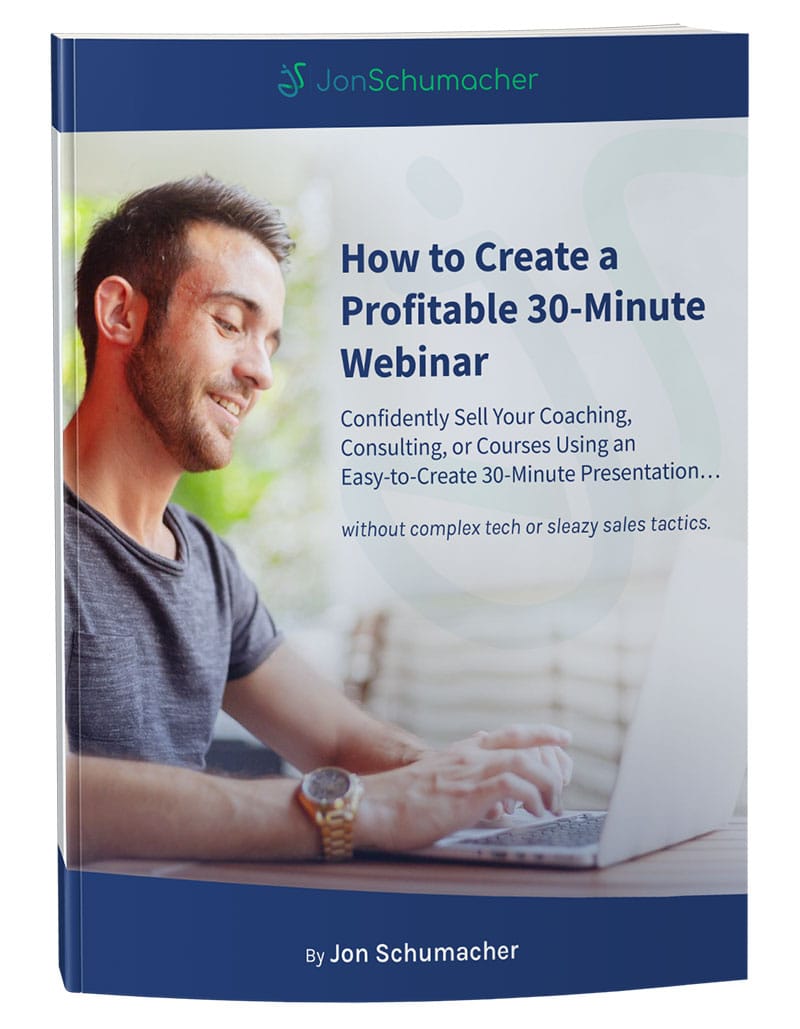A Step-By-Step Walkthrough of a Simple Five-Page Webinar Funnel That Brings You High-Paying Clients Like Clockwork

Prelude
I intend for this guide to be the single best piece of content on the internet with regards to Webinar Application Funnels. I am constantly testing and tweaking this process with my own funnels as well as my clients. I will be updating this document periodically with my latest experiments. Make sure to bookmark this page and share it with anyone who wants to scale their coaching, consulting, or services business.
Is This You?
You are a coach, consultant, or service provider who has proven your offer can sell. You are making over $100,000 a year selling to your referral network or local community, but you’ve reached a point where you want to grow. You want to expand nationwide or maybe even worldwide.
You’ve heard about these “magic” marketing funnels that can bring you clients from all over the world but you’re not sure how to build one.
You love the idea of a completely automated and scalable process that brings you prospects on autopilot so you can spend less time marketing and more time serving your clients or being with family and friends.
After working on more than 30 different webinar funnels these past two years, I have seen what works and what doesn’t work. The intention of this guide is to share some of my biggest lessons and recommendations.
I am going to introduce you to my Top Ten Filter Funnel (TTFF).
A simple five-page webinar funnel that can bring you prospects while you sleep, eat, walk your dog, or play with your kids. So what is the premise behind it?
According to marketing legend, Chet Holmes, around 3% of prospects are looking to buy right now. These are your most solution aware prospects who have a sense of urgency to solve their problem now. Another 7% are open to the idea of buying if you presented them with the right information. The reminding 90% do contain a few ideal clients but they are either not thinking about your solution, don’t think they are interested or know they aren’t interested in working with you. The TTFF helps you to…
- Enroll the top 3% right away. No use making them go through long, complex funnels or indoctrination sequences.
- Bring out the remaining 7% of ideal buyers through a short automation sequence and a long term nurture strategy.
- Build a massive leads list of potential prospects that grows every single day.
Who This is For
The TTFF is not for everyone. Below I have listed who this type of funnel is for and who it is not for so you can identify if it makes sense for your business goals.
You should consider having a TTFF built for you if…
- You are a coach, consultant, or service-based business.
- You are selling a program or service over $3,000 by phone.
- You have a proven offer that has sold well through referrals or your local community.
- You have case studies and testimonials of others successfully using your program or service.
- You are making more than $100,000 in your business (so you can afford to run paid traffic and hire help).
- You have the fulfillment capacity to add a large number of clients fast and still maintain results.
Who This Is Not For
The TTFF is NOT for you if…
- You are selling e-commerce or lower-priced (under $2,000) offers.
- You have a brand new offer you are looking to test (test it organically first).
- You are making under $100,000. You are still validating your offer and sales process and won’t likely have the funds to test and spend on paid traffic platforms (the exception is if you are getting a lot of organic traffic or affiliate traffic).
Overview of the Top Ten Filter Funnel (TTFF)
In layman’s terms, the outcome you are buying when you build a TTFF is quite simply to book your calendar with qualified prospects. If you want to scale and expand outside your current referrals and community this is the funnel that can do that for you.
This is accomplished through a series of five web pages, paid and organic traffic, a few emails, and an enrollment phone call.
Figure 1: Below is a simplified overview of the TTFF in diagram format:

I will show you more examples of ads, pages, and emails below but for now, let’s talk big picture. If you are not a marketing expert, this overview may be all you need to read to understand what we can build for you. If you are one of my digital marketing brethren, I will share more detailed specifics with you after the overview so you can use them for your own funnels.
The Simplified Description of the TTFF Process (For Non-Marketers)
1. Traffic. On the far left of Figure 1, we have traffic. Facebook ads, Facebook organic, Google ads, Banner ads, Google Search traffic and/or Youtube ads. The type of traffic source you use will depend on where your ideal client is best located. You need a way to grab the attention of your ideal clients on these platforms and direct them to your TTFF.
2. Lead Capture Page. We send that traffic to what’s called a “Lead Capture Page.” Some call this a landing page or a registration page. On this page, the visitor can enter their name, email address, or even phone number if you desire. This information is then added to a customer relationship management software or CRM which will allow you to market to them over the long term.
3. Webinar Page. Once the visitor enters their information, they are taken to your Webinar Page. On this page, the visitor is allowed to consume your marketing message in the form of on-demand video training. Usually, this training lasts around 18-25 minutes in length. I will discuss more details about the format of the presentation in an upcoming section. After watching your video, a percentage of the visitors will book a call with you. There is a button that appears below the video in the webinar room to allow them to click through to your Calendar Page.
4. Calendar Page. After clicking over from the Webinar Page, the visitor will land on your Calendar Page. Once on the Calendar Page, they will have a chance to book a call with you and your team. This page often has testimonials and other social proof elements as well as instructions for how to book.
5. Questionnaire Page. After booking a time, they will be redirected to a Questionnaire Page where they fill out more information about their goals and their business. The questionnaire helps you and your team to filter out those prospects who are qualified from those who are not.
6. Pre-Frame Page. After filling out the questionnaire, the prospect is directed to your Pre-Frame Page where they start to consume further content of yours before the call. This content can be an article you have written, a video, an interview you have participated in. You want to start pre-framing their thinking and behavior before the call so they see you as an authority and have been moderately indoctrinated about your teaching style and experience.
7. Pre-Call Sequence. Before the call, your prospect will receive email reminders and even voicemail or text reminders that contain the agenda of the call, more authority content for them to consume, and the date and time of the call. This step is critical as we want to get the prospect to take micro-commitments and start consuming more of our content before the call.
8. Enrollment Call. Once on the call with the prospect, I like to use what I call the “Doctor’s Script.” I will describe this in further detail in a section further down this post.
Ready to schedule a call with my team and I to discuss your TTFF? Click here to schedule a time.
Where Can You Use The TTFF?
As the diagram above shows, you can use the TTFF with Facebook, LinkedIn Google, Display Network, Youtube, or Instagram ads. You can place it on your website home page as a lead magnet or a pop-up. You can link to it from your social media profiles. You can have a link in your email signature. You can link to it as a call to action in a blog post like this one.
The BIG Four That Will Make or Break Your TTFF
After working with more than 30 of these webinar funnels, I have found there are four main reasons for success or failure.
1. Your Offer. As I shared above, if you have a new offer or have only sold a few times, now is not the time to build a TTFF. You still need to sell it manually to your existing connections before building out a funnel and selling to colder prospects. If you have an offer you have been selling well to referrals, your own email list, or with partners, this makes it more likely your offer positioning has a good “message to market match” and are thus ready for a TTFF.
2. Your Enrollment Process. High-end ($3,000-$10,000+) packages are best sold through a phone conversation. If your enrollment specialist is no good, you will struggle to make as much money as you could. I remember building a TTFF for a client. We loaded their calendar with calls. Many of them very qualified, but the enrollment person could not enroll them. In fact, after listening to his call recordings, he was literally repelling them. This obviously kills the profitability of your TTFF. If you have a strong enrollment person (they are not too hard to find) and a proven message to market match, you are more than halfway home to a successful funnel.
3. Your Hook/Presentation. Your webinar or video presentation will need to do a good job sharing your compelling marketing message. Your presentation should educate, shift beliefs, and excitify (my new word) your potential prospects into booking a call with you.
4. Your Ads. Your ads need to be highly relevant to your target client. More on the specifics of what makes a relevant ad shortly.
Your Tech Stack
- Clickfunnels for building the funnel pages.
- ActiveCampaign for your email autoresponder.
- Vimeo Pro for hosting the webinar video.
- ScheduleOnce for calendar bookings.
- Wufoo Forms for your questionnaire.
- Hellosign for e-signing contracts.
- Square mobile app to take deposits or send invoices.
- Google Slides for webinar presentation decks.
- Loom to record the presentation.
Diving Off The Deep-End
At this point, I’ve shared a high-level overview of the TTFF. Now I want to share much more depth with deep specifics. Like most things in marketing, there are all kinds of complex optimizations you can do. I find it best to test the core elements (Big Four shared above) before you test things like pre-funnel 50% video view retargeting campaigns or any pre-funnel content retargeting until you have tested the core elements (BIG Four) of your TTFF. More pieces lead to more friction and delays in getting data. I have consulted with at least a half dozen experts who told me they had burned through tens of thousands of dollars in custom audience building, pre-webinar retargeting content before they even had their core funnel working. Many complexity minded advertising experts with good intentions look to set up the whole enchilada before they test the meat, cheese, and beans inside. Don’t do this. Start simple. Test the Big Four and refine the basics first.
Live First vs Straight to Automated?
One quick digression before the specifics of the TTFF. I talked with a lot of experts who ask me, ”I heard we should test this live first before we automate.” It’s a good question. My answer is it depends. Certainly, if you are selling a course directly on the webinar (without an enrollment call) AND you have an email list or existing audience to test with (where you can get at least 100 sign-ups or more) I would test live a few times first. But for the TTFF where the goal is to book your calendar and the enrollment is done on the phone, I actually prefer to go straight to automated. This is the ultimate goal anyway. While each situation is different, it is not uncommon (assuming a good offer with a clear, targetable market, and a good enrollment specialist) to have a profitable automated funnel within the first few weeks. I was working with a client in the MBA admissions space who filled his coaching program within 6 weeks after spending $10,500 in ads and generating over $70,000 in revenue. He had a proven offer and was dynamic at enrolling when on the phone. Anyway, let’s get back to the specifics of the TTFF.
Your Relevant Ad
While you can certainly use organic traffic, the majority of people who want to build a TTFF want to scale outside of their current traffic sources. For that reason, I am going to show you a few examples of a Relevant Ad focusing on Facebook.
Key Metrics:
- Relevance Score (8-10)
- Link Click Through Rate Over 1%
- CPC Under $2 in Most Markets
- CPM Under $20 in Most Markets
When running ads on Facebook, you want to have a high relevance score (8-10) which means people are stopping on it, clicking on it, liking it, commenting, and sharing it. All these things signal to Facebook to serve this ad to more people at a lower cost.
A link click-through rate of over 1% means that a good number of people are actually seeing the ad and clicking through to your Lead Capture Page. After all, that is the goal of the ad.
When it comes to relevance score, having a good image or video thumbnail is 90% of stopping the scroll and getting people to click on your ad. The headline is a distance second.
Here is an example of an ad that scored 10/10 relevance and drove webinar signed ups for under $5:

In this case, Ryan was looking to target parents and college students who want to get into MBA schools. You can see the college building image as well as a very benefit rich and industry-specific headline.
Lead Capture Page
Your Lead Capture Page should be congruent with your ad headline. If your ad is a long-form copy or a video ad that explains the reasons why someone should opt-in for your presentation, your Lead Capture Page can be clean, simple and to the point. Most of the convincing to opt-in happens on the ad. Your Lead Capture Page simply gets their details.
Key Metrics:
- Opt-In Rate: 20% plus to cold traffic.
Here is an above the fold sample of an opt-in page:

Your headline should be benefit-focused, specific, unique, and curiosity provoking.
Your button should be above the fold and a strong contrasting color (orange or red for a white background). Make sure to have your paid traffic pixels on this page to retarget those who bounce.
Your Webinar
Here we have an 18-25 minute webinar (on-demand video presentation). Our goal is to get the most qualified, appropriate people to book a call. A case study works very well as an opt-in and also leads naturally to showing off your skills and building social proof for your offer. Otherwise, creating a short presentation is in order (see specifics below).
Key Metrics:
- Booking Percentage: 7-10% of webinar attendees.
- Cost Per Booking: $100-$250 (depends on your industry).
- Drop-Off Rate: 50% or more get to the call to action.
As a general rule of thumb we want at least 7%-10% of those who attend the webinar to book a call, however, just like Lead Capture Page opt-in rates, booking percentages can be deceiving as we only want the right people booking not just more people. You can see the drop-off rates of your webinar by using the analytics inside Vimeo Pro or Wistia.
Retargeting those who watch over 50% of your webinar to an ad that gives them a chance to book a call can dramatically decrease your overall cost per booking. This can be set up using Google Tag Manager.
Here is an example of a Webinar Page:

Your presentation should follow the following format (18-25 Minutes):
Note: In the image above, we are testing a from stage speech to see how that converts. The outline below would be for a short webinar presentation.
- Restate the BIG IDEA of Your Presentation
- Who Are You and Why They Should Listen to You
- Who This is For and Not For
- State the Problems They Face That Your Solution Will Solve
- Present Your Solution (System)
- Share Social Proof of That Solution (3-5 Case Studies)
- Image Language Future Pacing
- Call to Action to Book a Call
Restate the BIG IDEA. You want to welcome people and restate the headline.
Who Are You and Why They Should Listen to You? Share why you are teaching this presentation and your discovery of how you found the Solution you are sharing today. Talk about some of the successes you have had with your Solution.
Who This is For and Not For. You want to call out who this is for and who it is not for. Pretty straight forward.
State the Problem They Face That Your Solution Will Solve. You want to understand your ideal client so well you can state their problems better than they can. Talk about the feelings that go with these problems. Paint the picture.
Present Your Solution (System). Give a big picture walkthrough of your Solution System and how it solves the problems you shared. Make sure to connect the dots for them.
Share Social Proof of That Solution (3-5 Case Studies). Here we want to have client case studies that prove the System works and will work for those watching. Have a picture of the client with a short power quote. Video clips can be good here too.
Imagine Language Future Pacing. After sharing the Solution and Social Proof, get them to imagine what their lives would be like if they had these kinds of results. Widen the gap between where they are and where you and your clients are.
Call to Action to Book a Call. Here we want to get them to book a call. It is wise to name the call something attractive and talk about the benefits of booking. Audits are popular calls to offer. Could be an SEO Audit or a Revenue Growth Audit for those respective industries.
Your Calendar Page
Your Calendar Page is where people click through to book a call on your scheduling software. I like ScheduleOnce. It looks good on mobile and has an automatic redirect to your Questionnaire Page. At the top of the page can be a short video that gives people the next steps and starts the pre-call pre-framing. On this page, I also like to have a “testimonial wall” below the ScheduleOnce embed. I recommend you don’t allow people to book more than 72 hours into the future if running consistent traffic to your funnel or more than a week in advance for TTFFs that are on your website. Otherwise, people tend to lose momentum or even forget why they booked if you let them book too far in the future.
Below are some screenshots of one of my Calendar Pages. This page is currently on my website under “Build My Webinar.” It has booked well over $100,000 in consulting agreements directly from my website.



Your Questionnaire Page
After booking on your Calendar Page, ScheduleOnce will redirect them to your Questionnaire Page. For my clients, I tend to use Wufoo Forms for the questionnaire. This is your “filter” to qualify whether or not you or your enrollment team want to take the call. I regularly cancel more calls than I take.
A word on soft filters vs hard filter. The more questions and the tougher the questions you ask, the harder your filter is and the less likely people are to complete it. The fewer questions you have and the softer the questions, the softer your filter, and the more people will complete it.
Whether to have a hard or softer filter is very industry and situationally specific. If you are selling a leveraged program for $3,000 and your industry is in helping women who are struggling with body image and health issues, you will likely need to take more calls vs a $10,000 business offering.
Note: When starting a new funnel it is smart, to begin with, a softer filter. If you are booking calls with too many unqualified prospects, add more questions to the questionnaire to harden the filter.
What Types of Questions to Ask for B2B Businesses
Below are some of the most important questions I ask as a B2B consultant. The goal of your questionnaire is twofold. First, it dramatically increases the chances you only speak with qualified prospects. Second, it allows you to get the answers to common objections (Money, Timing, and Fit) before you even get on the call.
- How Did You Hear of Me?
- What Market Are You Working In and What Do You Sell?
- Share Your Website.
- How Much Are You Willing to Invest to Get Help?
- What is Your Currently Monthly Revenue in Your Business?
- How Much Would You Like to Make?
- How Big is Your Email List?
- How Much Website Traffic Are You Getting Per Month?
- What is Your Success Story?
- How Soon Are You Looking to Get Started?
- Are You the Financial Decision Maker for Your Company?
- I Have Programs and Services That Range From $3,000 to Over $100,000. Are you able to invest at least $3,000 if we decide to work together?
These questions put together are an extremely hard filter. I have these questions on my website TTFF. If I am running paid traffic and I want to bring in more volume of applications, I will soften the filter by reducing some of the hardest questions. Only ask the questions you need to qualify them. Don’t add questions just to add them.
Below is a screenshot of my website TTFF Questionnaire Page:

Your Pre-Frame Page
At this point, your prospects have watched your webinar, scheduled a call, and filled in the questionnaire. Now they land on the fifth and final page. Your Pre-Frame Page does a few things.
- It starts the pre-framing process so that your prospects see you as a trusted authority.
- It encourages micro-commitments.
- It starts the indoctrination process.
I often have a video at the top the page congratulating them on filling in the questionnaire and then telling them what to do before the call. It’s important to get your prospects to start consuming authority building content before the call. Videos, articles, interviews, and speeches that are relevant to your offer can work here. Make sure to set the agenda for the call on this page.
Below are a series of screenshots of my Pre-Frame Page:



Pre-Call Sequence
Your Pre-Call Sequence is designed to…
1.
2. Remind them about the call so they show up.
3. Give them the agenda for the call so they know how it will go and that you will make an offer if it makes sense.
Many sales experts will tell you to always have the prospect call into you. It’s not bad advice, I just don’t do it currently. I like having control of my output. However, this may be something I test more in the future. You could have a conference line that your prospects call to meet with you.
For your swipe file, here is my current pre-call copy template. I send this out right after people book a call. I have reminders with similar messaging at 24 hours, 1 hour, and 10 minutes prior to call.
Note: If you don’t have a ton of authority content, write a blog post or record a video that outlines who you are, what you have done, how the call will go etc.
I have received your booking for your [Name of Your Call].
If you have yet to fill out the questionnaire, this is REQUIRED to secure your call with me.
Click here to fill out the questionnaire > [Link to Your Questionnaire]
Before our call, I want you to do ONE thing, do your due diligence on me.
Put my name “Jon Schumacher” into Google and start reviewing the many interviews, videos, and presentations I have done.
To help you, here are a few pieces of content for your review > [Link to Pre-Frame Page].
Here is a list of testimonials > [Link to Testimonials]
My clients have made millions online. For the right person, I can help you too.
I will call the number you left at our scheduled time. Make sure to be at your phone, on time. If you miss our time, I may not reschedule with you (I am a stickler for being on time).
I will have a number of questions to ask you. I am nice but a straight shooter and only want to partner with the right clients, so there will be no hard pressure to enroll, only finding out if you are a good fit.
The Agenda of the Call Will Be:
1. I will ask about your current situation and goals to make sure you are ready for a webinar (some aren’t and I will tell you if that is you).
2. I will lay out a big picture plan for how to get where you want to go.
3. If I feel like working together makes sense, I will make you an offer to do so.
This isn’t a “pick my brain” type call. This is a call to see if working together makes sense. So please be serious about hiring my team and I if you are coming to the call.
Looking Forward!
Jon
Enrollment Call
As I am writing this section, I am debating on how much detail to include here. The art of enrollment is something entire industries are built on. Sales training is a mega-topic. While I give my clients entire scripts and frameworks to follow, I have decided for the sake of this not being a 10,000-word post, to focus on sharing what I call my Doctor’s Script for Enrollment Calls.
Note: The velocity of the enrollment process will vary depending on WHO your ideal client is. Most of the price points sold through my application funnels have been in the $5,000-$20,000 range. The velocity of enrollment for these offers is often shorter and the following sequence can make a lot of sense. As of this writing, I am also in the process of working with bigger 6-figure up to 7-figure single deals. Most of these deals have a slower velocity to enroll and are built on much deeper initial relationships. One call closes, or looking to grab a card on the first call is not a good idea for these massive deals. The following sequence is written for coaches, consultants, and service providers who tend to sell faster velocity type offers.
Key Metrics:
- Enrollment Rate: 1 of 5 is considered good for colder prospects. I have seen 1 of 8 bring a 4x ROAS. Don’t get too caught up with the enrollment rate in isolation. Look at the ROI numbers first. Then if there is an issue dig into conversion metrics (more on this soon).
- The Cost to Acquire a Customer (CAC) 8-10 to 1 (If your program is 10k, shoot for $1,000-$1,500 CAC)
Prepping for the Call. Make sure you have your Doctor’s Script open on your computer. If I have time, I often practice in my head for a few minutes before the call. I call it “running the tapes.” Don’t underestimate the power of visualization and mental exercise to prime your mind for your calls. I always have a blank piece of paper on my deck. What my mentor Adam Urbanski calls a “Blank Page Pitch.” Before the call, I will look at their questionnaire and determine what would be the best offers I can prescribe them based on their current monthly revenue and goals. I have several offers at price points that range from as low as $5,000 for a “try me” offer to as much as $1M (have not sold one yet but working on it). I will write down the top revenue offer based on their questionnaire as well as two others I can downsell to if I want to work with the person and but I am getting pricing or other objections. Adding a lower-priced and short term frontend offer, what I call a “Try Me” offer can do wonders to open new working relationships with prospects, particularly if you get a lot of colder leads as I do. Creating your offer sequencing could be another 5,000-word post (coming soon). Anyway, I digress, back to the Doctor’s Script.
The Doctor’s Script for Enrollment Calls
Answering or Calling. How you greet the prospect sets the tone for the call. You never want to call and say,” Hi, is X there?” This is weird and can throw them off. Below is the phrase I use when calling a prospect.
If you are calling and they answer: “Hi, this is [Your Name] calling for [Their First Name].”
If they call you and you answer: “This is [Your Name].”
Building Rapport.
In B2B sales, I tend to keep this short. Spend a couple of minutes building rapport. My favorite way to do this is to ask “where they’re located?” If I know their location, I ask, ”How are things in [city location]?”
After briefly building some rapport, I say something like “Well, I’m excited to be on the call with you and learn more about your business.”
“By the way, what was the reason you decided to reach out to me specifically right now?”
Diagnosis Of Their Situation.
“Tell me a bit more about your current situation.”
- Tell me what you are trying to do over the next 6 months?
- What have you tried before?
- What do you feel is stopping you from getting where you want to go?
If you are in a non-business niche, ask them about their (relationship, health goals, etc).
Defining the GAP.
Dig in a bit. You want to know where they currently are, what problems they are having, where they want to go. Write down their biggest problems on your sheet of paper.
Customize Your Own Script.
Decide what questions you need to ask them to KNOW if they are a good fit for your offer.
For example, in my niche, I need to know what they are selling, how they are selling it, how many they have sold, pricing, email list size. What their average customer lifetime value (CLV) is so I can compare my fees to that number.
Prescribe The Solution.
Now that you have heard what their main problems and goals are, you can PRESCRIBE them your solution based off THEIR problems. Be careful not to overwhelm them or try to solve their entire problem on the call. Keep it big picture. Share example stories or case studies from past clients.
Examples:
“Got it. Based on what you shared with me with, here is/are the big reason/reasons you’re webinar is not performing well.”
“Here’s the problem, you aren’t using the assets you do have. You are wasting time with complex funnels.”
“Based on what you tell me, I think a summit would be perfect. I have helped X number of students make X amount of money using them. For example [insert case study]…”
Enroll with Your Top Offer.
Restate the problems they said they are having and how you can help them.
“Based on what you have shared with me, this is how I feel I can help you best…[insert best offer].”
Share the outcome of your program.
Example: “In 8 weeks you will have a complete evergreen webinar funnel set up plus the ads to fill the funnel with new leads.”
Price revealed.
“The Cost is $4,000 per month for 3 months or you can pay $10k in full.”
***After sharing the price, SHUT UP!! Don’t sell anymore. That part is over. You are looking for a “yes, let’s do it” or some kind of objection or question.
Them: Great, sounds good.
***You: “Awesome, I am excited to work together! I have your email address already. What is a good billing address for the card you would like to use?” I find this is a softer transition to asking for their card than “what is the number on your card?”
They share their address…
You: “What’s your Card number? Expiration? The number on the back?”
Look to get payment on the phone if you can. If not the entire amount, look to get a deposit if they want to work together but can’t start right away.
OR (if objections come up, and they often do)…
Be ready to respond to them by preparing answers to the most likely objections: money, timing, and fit of your program.
Overcoming Objections
Odds are people will have some kind of objection, particularly if they are a colder inbound prospect but even with direct referrals. It’s usually around price, timing, or fit all wrapped into the biggest issues, trust, and clarity.
If your ad, your TTFF, and your Pre-Call Sequence are full of social proof, this certainly helps reduce the resistance to price and trust objections.
Examples of the most common questions or objections:
Can you tell me how it works?
That price is too much.
I have so much going on right now, I don’t know if the timing is right.
I am already doing this with someone else, I not sure I need this right now.
Let me think about it.
Can you send me a proposal?
Can I see references or case studies?
Let me talk to my partner.
Be prepared with answers to all of these questions. Write down your responses on your phone script and study them. Practice in the mirror answering objections.
Rebuttals to Objections
Almost all objections coming down to three things. The first is they are not financially qualified. Meaning your filter didn’t do a good job of qualifying. Second, you are not talking with the sole decision-maker. Third, if you have qualified well and know they are the decision-maker, it comes down to trust, value, and priority.
When you get statements like “Let me think about it,” your job at this point is to find the REAL objection.
Sales expert Victor Antonio (subscribe to his channel and study it) has a great framework for digging in a bit deeper.
Here is your rebuttal to the “Let me think about it” objection.
“Usually when people say “I would like to think about it” they are either not interested and just being nice, or they are interested, but they aren’t quite sure. Which one are you?”
Most will say they are just not sure or even volunteer the real objection.
If they say “not sure,” you say, ”Usually when people are unsure, it’s either around money, timing, or fit of the program. Which one would you say it is?”
See how you are leading them towards their real objection so you can address it. That is the art of enrollment.
Let’s dive into some specific objections.
Money objections. Assuming qualification, this objection is always because the image in the prospect’s mind is not clear on the VALUE your offer is providing compared to the cost.
A good rebuttal could be, “I see [always confirm what their objection was]. You are right it is expensive, but are you more concerned with value or price?”
They will usually say value. No one wakes up looking to pay an expense but everyone is looking to invest in their business in exchange for value beyond their investment.
Comparing your fee to their customer lifetime value (CLV) is a good way to put pricing in perspective. Do the math with them.
If you are in a non-business niche, compare your fee to the cost of inaction or other more expensive services. For a relationship company, it could be the cost of divorce or the expense of year-long counseling.
Money objections are really TRUST and VALUE objections.
Timing objections. This can be the hardest to overcome and there really are situations where the timing doesn’t make sense. As a consultant who can see the bigger picture for my potential clients, if the timing is indeed not right for them, I will tell them.
Timing objections are really PRIORITY objections. You haven’t done a good job in showing the prospect why what you are offering is a priority, assuming it is.
Offer fit. Remind them of the earlier part of the conversation where they had agreed with the solution you had prescribed to their problems. Restate the main problems you had written down and tied them again to your offer. If the objection continues, ask, “what do you see as missing from my current offering that you need?” As always, asking questions to hone in on the real objection is the skill to develop.
I need to speak to my partner. This should have been ruled out before the call but if not, set another meeting with the partner shortly after.
If more time is needed, always set the next meeting time on the call. You don’t want open ends where you have to follow up and ask “when are we meeting next?”
After the call…
Send them a summary of the benefits email. Here is what we are going to accomplish when we get started.
If they are a no right now but you think they would be a good client, enter their information into a special CRM like Contactually and share relevant information with them on a quarterly basis. You never know when the timing will be right.
Finding Help For Your Enrollment Calls
It is smart to start looking for help with your enrollment calls early if you are selling a higher volume group program or productized service. Giving an enrollment specialist 10% of each sale closed is a common practice. Often you can find people who are well-spoken in your current tribe. If your business is based on volume then you will need to be active in looking for potential constraints in client acquisition and fulfillment. For client acquisition, it is usually around taking enrollment calls. In order to scale, you will need to take a lot of calls and you will need help to do that.
A Word on Looking at the Right Metrics
Start with the big picture. If you see a problem, look deeper, but only if you see a problem. Test to improve profit, not just to improve conversion metrics.
The ONLY metrics that really matter (from a marketing viewpoint) are Lifetime Value per Lead (Revenue Per Lead) and Return on Ad Spend (ROAS). I call these ROI metrics. They are what matter. Well, client results and working with the right people is what matters but from a funnel profitability standpoint, this is what to look at first.
If you have an issue with profitability or testing and improving your ROI metrics then you need to look deeper to find the constraints in what I call Conversion and Consumption metrics.
When looking at these metrics start at the front and work backward.
Does our ad have a good relevance score and link click-through rate?
What is the opt-in rate for our Lead Capture Page? Is it under 20%, what hooks can we test to lift this?
Note: Cost per lead and opt-in rate can be the most deceiving metrics if looked at in isolation. It is possible for a funnel with an opt-in rate of 15% to be more profitable than one with a 30% opt-in rate. That is why we always look at ROI metrics first.
Do we have a sharp drop-off at a certain point in the presentation? You can see this data inside Vimeo Pro or Wistia.
What percentage of people are booking a call after seeing the call to action? Is it 5%? How can we lift this? The more compelling name for the call? More benefit-focused descriptives of why they should book?
What is it costing us to get a booking? Over $200? Is there a way to get this lowered but still have quality prospects and increasing revenue?
Poor No-Show rate for the Enrollment Call? How do we get more prospects showing up for the call?
Are people the right people booking a call? If so, are we not enrolling them well? Is our enrollment rate 1 in 10? How can this be better? If they are not the right people, maybe we need a different ad source?
Long Term Nurture
During this post, we only discussed the “Yes” portion of the TTFF. The one where someone opts in, watches your presentation, books a call, fills in the questionnaire, and comes to the enrollment call. Beyond that, I usually have a short five email automation sequence which acts as an indoctrination process. It also pushes people to book a call.
The vast majority of your prospects are not going to be ready to book right away. The timing may not be right or they just don’t do business with people who they haven’t followed for a while.
That is where your long term nurture comes in. If you look at the biggest brands using application funnels right now, they combine paid traffic automation (usually a webinar) with long term nurture strategies like regular (often daily) email broadcasts, Facebook lives or posts in their group.
I recommend for most niches to build both your email list and a Facebook group that you engage with regularly. This comes down to having a regular content marketing schedule as well as several promotions where you do date based pushes for enrollment calls.
I will likely do another mega-post sharing my content marketing and organic marketing strategies soon.
When you combine the power of the TTFF automation with a strong organic strategy, a high-end offer, and a powerful network of relationships you have the makings of serious growth for your coaching, consulting, or service business.
Ready to Discuss Building a TTFF Application Funnel For Your Business?
If you have read to this point, you are obviously serious about enrolling more clients and scaling up your business.
But this all may seem very overwhelming.
After all, you will need to…
- Set up all your web pages
- Integration your CRM
- Place your Facebook and Google Tracking code in the proper places
- Write amazing copy
- Set up all the software tools
- Set up and manage your ads on multiple platforms
- Figure how it all works, on your own. Yikes.
If you want to figure it all out on your own, spend A TON of time and money shooting in the dark, you are more than welcome to take this post, save it to your computer, and have at it.
Odds are it won’t be fun and you will end up losing loads of time and money doing it.
If you just want to hire the experts to help you (good idea)…
I want to invite you to book a call with my team and I.
If you know you are ready to talk right now, BOOK A CALL WITH ME
Fill in your information on the following questionnaire, and we can discuss creating a TTFF for your business.

